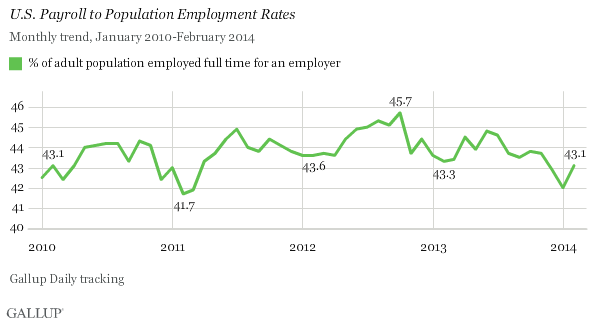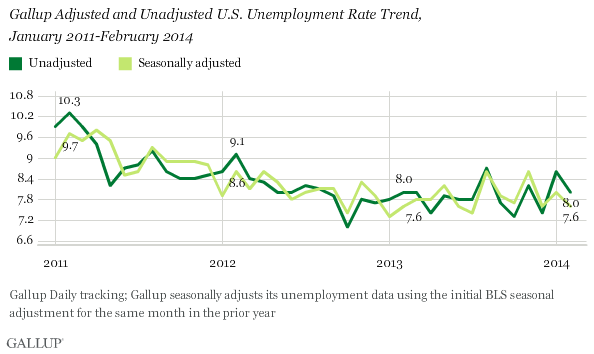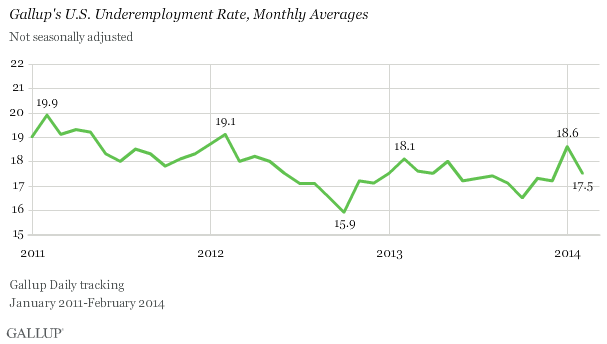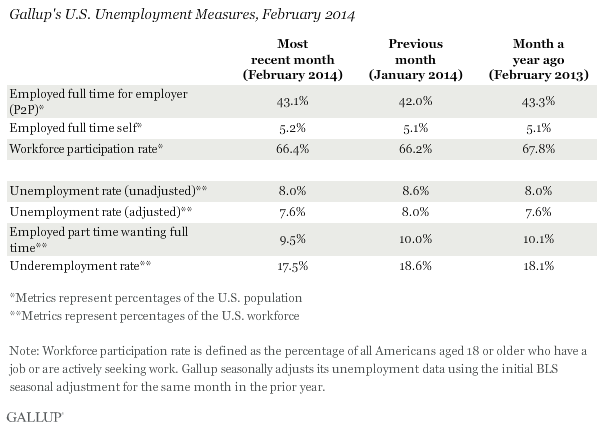WASHINGTON, D.C. -- The U.S. Payroll to Population employment rate (P2P), as measured by Gallup, was 43.1% in February. This was up slightly from 42.0% in January but similar to the 42.9% from December. P2P remains below the averages for 2013 (43.8%) and 2012 (44.4%).

Gallup's P2P metric tracks the percentage of the U.S. adult population aged 18 and older that is employed full time by an employer for at least 30 hours per week. P2P is not seasonally adjusted. However, because of seasonal fluctuations, year-over-year comparisons are often helpful in evaluating whether monthly changes are attributable to seasonal hiring patterns or true growth (or deterioration) in the percentage of people working full time for an employer. On the basis of that comparison, the P2P rate for February 2014 is steady, compared with the 43.3% found in the same month last year and the 43.6% in February 2012.
The latest results are based on Gallup Daily tracking interviews with approximately 26,000 Americans, conducted Feb. 1-28, by landline telephone and cellphone. Gallup does not count adults who are self-employed, working part time, unemployed, or out of the workforce as payroll-employed in the P2P metric.
Seasonally Adjusted Unemployment 7.6% in January
Unlike Gallup's P2P rate, which is a percentage of the total population, traditional employment metrics, such as the unemployment rates Gallup and the U.S. Bureau of Labor Statistics (BLS) report, are based on the percentage of the workforce. Gallup defines the "workforce" as adults who are working or actively looking for work and available for employment. The U.S. workforce participation rate in February was 66.4%, steady with January's 66.2% but down from 67.8% in February 2013.
Gallup's unadjusted U.S. unemployment rate for February is 8.0%. Gallup's seasonally adjusted U.S. unemployment rate for February, using an estimate of the government's likely adjustment factor, is 7.6%. Gallup calculates this rate by applying the adjustment factor the government used for the same month in the previous year. Last year, the government adjusted February's rate downward by 0.4 percentage points. The exact adjustment the government uses for February 2014 will not be known until Friday's BLS release.

While Gallup and BLS data are based on robust surveys, the two have important methodological differences. Gallup's employment numbers generally correlate with BLS rates, although the two will differ from month to month, in part reflecting that Gallup's numbers tend to have more month-to-month variability than the more controlled BLS estimates.
Underemployment, as measured without seasonal adjustment, was 17.5% in February, down from 18.6% in January, and from 18.1% in February 2013. Gallup's U.S. underemployment rate combines the percentage of adults in the workforce who are unemployed (8.0%) with the percentage of those who are working part time but looking for full-time work (9.5%).

Bottom Line
The overall percentage of the U.S. adult population that is employed full time for an employer has generally been lowest in the first quarter of each year since Gallup began tracking it in January 2010, and has peaked in the summer and early fall. Looking at P2P by year, 2010 saw a rise and equivalent fall, beginning the year at 42.5% and ending at 42.4%. However, P2P rose relatively steadily from February 2011 (41.7%) through most of 2012 -- despite a small fourth-quarter 2011/first-quarter 2012 trough. That rising trend ended in October 2012 with P2P at 45.7%, after which it fell two points in one month and -- despite another small seasonal rise in mid-2013 -- it has been on a generally downward trajectory ever since.
P2P rose to 43.1% in February from 42.0% in January this year, which was the lowest level since March 2011 (41.9%). Last month's reading is on par with February readings in the prior two years but, unlike in 2012 and 2013 when P2P fell or was flat between January and February, this year it increased slightly. It remains to be seen whether the February measurement is the beginning of a turnaround for payroll employment or if this reading is an anomaly that again precedes a P2P retreat in March.


![[Most Recent Quotes from www.kitco.com]](http://www.kitconet.com/images/quotes_7a.gif)
No comments:
Post a Comment